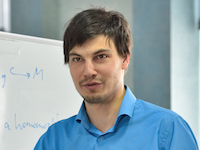|
|
Dynamics in Siberia - 2019
28 февраля 2019 г. 10:00–10:50, Новосибирск, Институт математики им. С.Л.Соболева СО РАН, конференц-зал
|
 |
|
 |
|
Пленарные доклады
|
|
|
On homology of Johnson kernel
А. А. Гайфуллин |
| Количество просмотров: |
| Эта страница: | 304 |

 Фотогалерея Фотогалерея
|
Аннотация:
Let Sg be an orientable closed surface. The mapping class group Modg is the quotient of the group of orientation preserving homeomorphisms of Sg onto itself by the group of homeomorphisms isotopic to the identity. The mapping class group contains a lot of interesting subgroups. The most important of them are the Torelli group Ig and the Johnson kernel Kg, Kg<Ig<Modg. Recall that the Torelli group consists of all mapping classes in Modg that act trivially on homology of Sg. In other words, Ig is the kernel of the natural surjective homomorphism Modg→Sp2g(Z). The Johnson kernel Kg admits two different definitions. First, it is the kernel of the so-called Johnson homomorphism
τ:Ig→⋀3H1(Sg)ker[H1(Sg)−∧Ω→⋀3H1(Sg)]
induced by the action of Ig on π/[[π,π],π], where π=π1(Sg). (Here Ω∈⋀2H1(Sg) is the inverse of the intersection form.) Second, Kg is the subgroup of Modg generated by Dehn twists about those curves that separate Sg. So the group Kg is often called the bounding twist group. The equivalence of the above two definitions of Kg is a deep result due to Johnson (1985).
In 2007, Bestvina, Bux, and Margalit constructed a special cell complex called the complex of cycles on which the groups Ig and Kg act, and used it to study the homology of Ig and Kg. They proved that the cohomological dimensions of the groups Ig and Kg are equal to 3g−5 and to 2g−3, respectively. Further, they proved that the top homology group H3g−5(Ig) is not finitely generated. However, they did not manage to obtain the same result for the top homology group of Kg. This will be the main result of the talk. Namely, we shall show that the group H2g−3(Kg) contains a free abelian subgroup of infinite rank.
Язык доклада: английский
|
|



 Обратная связь:
Обратная связь: Пользовательское соглашение
Пользовательское соглашение
 Регистрация посетителей портала
Регистрация посетителей портала Логотипы
Логотипы